2023 seems like an appropriate point at which to pause, and take stock of the Irish car market. A decade ago, new car sales started to recover from the disaster of the 2008 financial crisis and resulting recession, and while there has been hardly any lack of economic body-shocks since — Covid, Brexit, semi conductors and Ukraine are merely the highlights (or lowlights one might say) — we can at least stop and take a look at how the market coped, and where it might be heading.
The first fact that comes up, and one which might surprise given recent concerns that SUVs and crossovers are taking over the entire market, is that the best-selling car over the course of the last ten years has been the Volkswagen Golf. Indeed, with 128,635 sales in the past decade in Ireland, VW is the top-selling brand overall, and when one remembers that the top-ten selling brands also include Skoda and Audi — part of the VW Group as a whole and part of VW Ireland — then the performance becomes even more impressive. But which cars were the most popular?
What were the top ten best selling cars in Ireland of the last ten years?
2013 to 2022
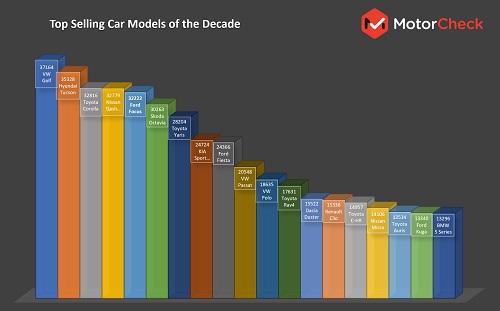
- VW Golf
- Hyundai Tucson
- Toyota Corolla
- Nissan Qashqai
- Ford Focus
- Skoda Octavia
- Toyota Yaris
- Kia Sportage
- Ford Fiesta
- VW Passat
The Golf, with 37,164 sales in that period, has clearly been the cornerstone of VW’s success, and it was the top-selling car in Ireland for several of those years.
However, while that might paint a somewhat rosy, even rose-tinted picture of the Irish car market — one that is still traditional in its tastes, and which buys mostly sensible family hatchbacks, the fact is that the Golf currently does not even appear in the 2022 or 2023-to-date top-ten sales list, and its position has been thoroughly usurped by SUVs.
That fact is evinced by the performance of the Hyundai Tucson. This mid-size family SUV has only started to sell in large numbers since 2016. Even with a three-year head start for the Golf, the Tucson — spread across two generations — has run the Golf impressively close on 35,328 sales, and given the way 2023’s sales figures are going, it will probably usurp the Golf by the end of this year.
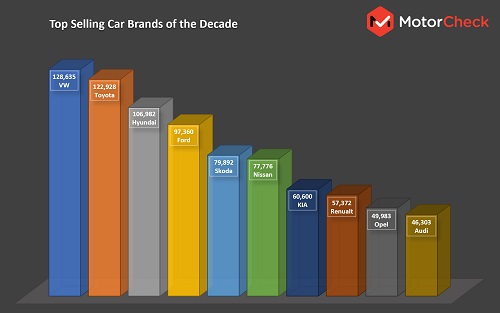
The Tucson has helped Hyundai to third place overall in the best-sellers of the decade chart, on 106,982 sales since January 2023. That puts it slightly behind Toyota, on 122,928 sales. Toyota’s sales success has been spread across more than one model, however. The Corolla hatchback and saloon have sold a combined 32,816 units since 2013, which is doubly impressive when one remembers that up until 2019, the Corolla was sold only as a saloon, alongside the hatchback Auris — which itself racked up 13,534 sales in the decade, putting it in the top-20 sellers. It was only in 2019 that the Auris name was dropped and the Corolla became a model range of saloon, hatchback, and estate once again.
Indeed, combine the Auris sales with those of the Corolla — which one might be tempted to say is cheating slightly, but it’s a worthwhile exercise — and you get a total 46,350 sales — eclipsing those of both the Golf and the Tucson.
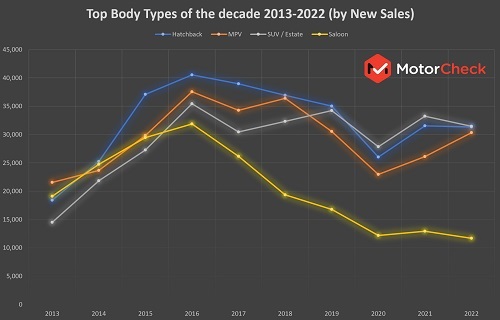
Nevertheless, there is a clear peak point in the graph at which SUVs start to take primacy and it’s 2017 — the year after the second-generation Hyundai Tucson was launched, and when it first took the top-selling car spot in Ireland. There is a little confusion in the figures, as pointed out by Motorcheck’s managing director Michael Rochford: “The graph on body types by year shows that saloons fell away sharply after 2016 and SUVs continued to rise, but hatchbacks never really fell away. Although it’s difficult to be precise since some of the vehicles that are classed as ‘hatchbacks’ or ‘MPV; at registration could conceivably fall into the small SUV category but unfortunately they are registered with a different body name. For example cars such as the Seat Arona, Renault Captur, and Renault Arkana are all logged as hatchbacks, as is the Toyota C-HR.”
So it’s important to dig into the figures, as Rochford emphasises: “Perhaps it is more telling that in 2022 the only three body types worth taking about are the SUV, Hatch and MPV and all three are almost on an equal footing whereas the saloon has fallen away completely. If you look at the picture in 2022 you see that seven of the top ten selling models are SUV or mini SUV and of the three others in the top ten that are not SUVs, two are on the decline in terms of sales…”
That’s a fact backed up by the car in fourth place in the sales charts — the Nissan Qashqai. Another perennial best-seller, the Qashqai has, with 32,779 sales, come within a handful of unseating the Toyota Corolla’s third place, and has sneaked past the Ford Focus, which with 32,222 sales started the decade strongly, but which has fallen away dramatically in recent years. Ford has in fact confirmed that from 2025, the Focus will no longer be in production and will effectively be replaced by the Puma compact crossover.
The next two cars in the top-ten sellers of the last ten years one might consider more conventional models. The Skoda Octavia, in sixth place with 30,263 sales, is indicative of the massive leap in popularity that Skoda has enjoyed really in the past two decades, not just since 2013. Once a brand which would have been anchored well outside the top-ten sellers, Skoda is now regularly in fourth or fifth place overall for sales, and the Octavia has proved perennially popular.
As has the Toyota Yaris, in seventh place, with 28,204 sales which pushed out the Ford Fiesta, on 24,366 sales. That represents something of a passing of the small car torch — the Yaris, which is now quite an expensive car in relative terms, and which is sold largely as a hybrid-engined model, will continue in production for some time, whereas the Fiesta will end its production run this year, after almost 50 years on sale.
In between those two affordable (relatively) small hatchbacks is the Kia Sportage, with 24,724 sales to its name. Again, this is emblematic of the general shift away from small, cheap hatchbacks to larger, more prestigious, and significantly more expensive SUVs.
Rounding out the top ten Irish selling cars of the last ten years is the oh-so-sensible Volkswagen Passat, and its 20,548 sales are — like those of the Ford Focus — based largely on its performance in the early part of the decade. It’s long since been nudged out of the current top ten sellers by SUVs and crossovers, including Volkswagen’s own Tiguan.
There are some other interesting nuggets to mine. In 13th position in the decade’s best-sellers list is the Dacia Duster, which only launched on the Irish market in 2014, so lost a year out to most of the other badges here. It actually out-sold the more affordable Renault Clio — Renault owns the Dacia brand, don’t forget — so it’s equally indicative of the move towards SUVs, but at a much more affordable level than the likes of the Tucson and Sportage.
BMW’s 5 Series saloon just broke into the top 20 sales, largely on its performance in the early part of the decade when it was both enticing affordable (prices in 2013 started at just over €40,000) and had impressively low CO2 emissions thanks to an efficient 2.0-litre diesel engine.
Which itself raises a question — where are all the electric cars?
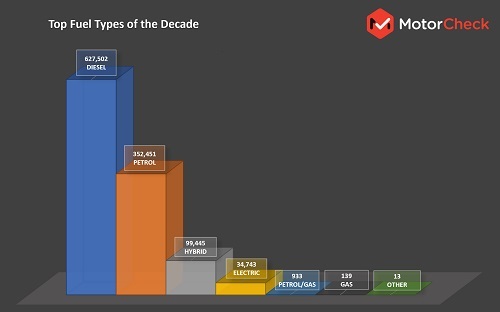
Simply put, they haven’t sold enough yet to get into the overall figures. Electric sales have only really taken off — from a very low base — in the past three years, but it won’t be long before the likes of Volkswagen’s ID.4 and Hyundai’s Ioniq 5, not to mention the Tesla Model 3, start to make an impact on this list.
If one looks at the graph of fuel types sold in the market, diesel-engined cars are in a clear ascendancy up till 2016 — when the effects of the diesel emissions scandal started to be first felt. After which, diesel car sales fall precipitously to 2020, where they level out slightly, and in late 2021 they are overtaken by petrol car sales. Given the dreadful publicity surrounding the emissions scandal, it’s perhaps surprising that it took five years for petrol to overtake. However, those petrol sales have to be — up to a point — combined with hybrid-engined sales (almost all hybrid-engined cars have a petrol component) which really take off from 2019 onwards. Unsurprisingly, this coincides with the introduction of the current Toyota Corolla in hybrid form.
Electric? From 2013 to 2018 it bumps along the bottom of the graph — indicative of the fact that only a tiny number of electric cars were actually on sale in that period, and really only the Nissan Leaf and Renault Zoe in any significant number — but from 2019 onwards there’s big uptick, and by 2022 the graph of electric sales is pointing upwards at a very sharp angle.
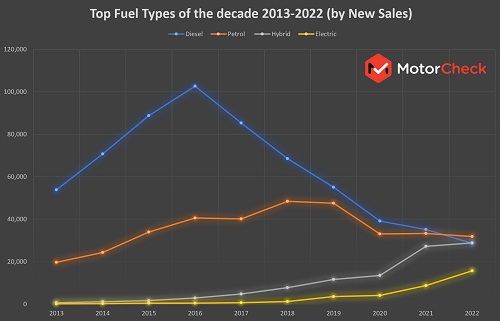
When you look at the graph of the best-selling brands, Toyota’s line is the most striking. Having been the best-selling brand in 2016, it then tails off for several years, but makes an almost-about-face in 2020, rocketing to the top and accelerating fast away from most of the other brands. Indeed, by 2022 most of the major brands are on a gentle downslope, but Toyota, Hyundai, Kia, and Dacia are all pointing noticeably skywards. It’s likely then that these will be the key brands for the next ten years in Ireland.
What will we see next?
It will be interesting to return to these figures in 2026, to see what ten years of SUV dominance in the sales charts looks like. Equally, electric cars ought to be more significant by then, and we may see the entry into the top-ten decade sellers of the likes of Tesla and possibly others. What’s abundantly clear is that we’re at an inflection point right now. The once-unassailable Irish sales positions of ‘traditional’ hatchbacks and saloons is gone, and we’re now firmly into both the electric and SUV eras. Irish buyers are also spending far more on their cars than was once the case — remember that in 2000, still the all-time peak for new car sales, the best-selling model was the cheap and cheerful Fiat Punto, which cost as little as €13,000. In 2022, the best seller was the Hyundai Tucson, which costs, at its cheapest, €37,000.
What will that mean in the long term? We’ll come back in a few years and find out. In the meantime, let us know which car or cars you bought in the past decade. Did you switch from a hatchback or a saloon to an SUV? Have you gone electric already? Did you stay loyal to a certain brand in that time, or did you shop around? We’d love to hear your stories. Drop us a line on support@motorcheck.ie and remember to include ‘Ireland’s top ten selling cars of the decade’ in your subject line.